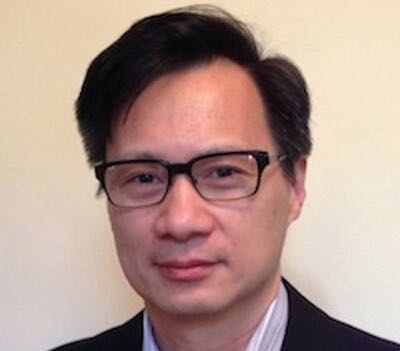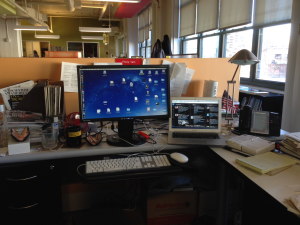
What I’m working on:
As a managing editor, I do a lot of different things to keep the editorial flow going and the business gears turning on the digital side of the magazine. Aside from giving direction and feedback on story coverage, I might have to sign off on invoices and contracts, evaluate content partners and potential vendors (the majority of functions on any web site—such as commenting, purchases, and ads—are handled by third-party vendors), and coordinate editorial plans with the sales and promotion teams. I have learned to become comfortable using words like upsell, cross-sell, curate, and revenue-stream dynamics, without my eyes glazing over.
Currently, I am reworking an agreement with one of our news service providers; preparing for a corporate initiative about internal job structures (Scientific American is owned by Macmillan, which employs more than 5,000 worldwide); recommending and preparing entries for a major magazine award; and pulling together a list of upcoming special reports that may be of interest to other divisions in the company. On an ongoing basis, I put together one weekly and five monthly e-newsletters called Briefings and a monthly digital publication called Classics, which mines an archive that dates back to 1845.
Today is also my turn to be the daily editor for website stories. This job rotates among the senior staff, and I get to do it about three times a month—it’s the fun part of what I do.

Where I work:
I work in New York City on the corner of Varick and Canal Streets—that’s right outside the Holland Tunnel entrance. I can give you traffic updates. The building used to house a printing plant, so we’ve got high ceilings and oversize windows—it’s very bright and airy. In mid-2015, though, we’ll be moving south, to 1 New York Plaza. I work in an open floor plan, and my physical desktop is rather cluttered, but my computer desktop is fairly neat, I think.
Daily routine:
If I don’t have any morning meetings, I’ll get in between 10:00 and 10:30 a.m., although I actually begin my workday earlier—I start reading my emails on the subway ride in (several stations have connectivity underground now).
If it’s Monday, then we’ll have an editorial board meeting to determine our online coverage plans for the week and review proposals for the magazine features.
Otherwise, I’ll spend my first hour responding to emails and checking my Twitter feed—which I use as a news reader—especially when the spinning beach ball appears on my computer to indicate that Outlook is doing … something. After that, I’ll tackle my projects, attend meetings, and respond to emails—I just counted 221 that entered my inbox last Monday. I took the good advice from a friend not to send work emails on the weekend, unless it’s truly urgent.
I’m in the office 9 to 10 hours a day, and typically I eat lunch at my desk. I’m finally in the habit of going to the gym every day, although if The Rachel Maddow Show comes on the television there, then I know I’ve stayed too long at the office. When I get home, I tackle some of my responsibilities as the current New York chapter president of the Asian American Journalists Association (AAJA)—mostly it involves organizing volunteers and partners for various meetings, programs, and events in an effort to increase diversity in the newsroom.
Most productive part of my day:
If I need to write, it’ll be after 6:00 p.m., when the office activity drops enough to be less of a distraction. It’s a double-edged sword, though: At 6:00 p.m., the HVAC system shuts off, quieting the blowers that provide white-noise cover. When they’re on, it kind of sounds like you’re in an airplane. Without the rumble, you can easily hear conversations from 50 feet away. When I was working on a book and writing at home, I started at 11:00 p.m. and wrote to 2:00 or 3:00 a.m. during the weekdays.
Most essential ritual or habit:
My morning routine of coffee, some kind of carbohydrate, The New York Times (on paper!) and the radio tuned to WCBS news, because it keeps reminding me of the time.

Mobile device:
iPhone 5—I don’t know how I got by without one before. Well, I do, but I had to carry three devices. I do wish the iPhone had the haptic feedback of Android phones, though.
Computer:
At the office, it’s a 13.3-inch MacBook Air, connected to a 21-inch external display. My home system consists of an iMac and another iMac. I also still have a first-generation iPad, for magazine apps. Yes, I drank Apple’s Kool-Aid.
Essential software/apps/productivity tools:
I use Chartbeat and Webtrends for website analytics—they show which stories are spiking and the sources of traffic, among a lot of other data. I also use a tool called Outbrain—it shows how often site visitors click on particular stories on the homepage and provides rudimentary headline testing (tip: lists and numbers still work well). We display our content to the world via a customized version of Mura, an open-source content-management system, and we use WordPress for our blogs.
I also rely on the usual Microsoft Outlook, Word, Excel, and PowerPoint, and Adobe InCopy to fit designed pages (magazine publishers mostly use InDesign to lay out their issues). I use Preview to view, size, and crop images, and TweetDeck to organize my Twitter feeds (plus, it transfers the lists to Twitter for mobile).
My favorite mobile app is a password manager called Wallet—it stores all my log-in credentials. I also love the camera app, which I use as a memory aid, especially at talks, where I like to shoot on-screen slides.
Favorite time waster/procrastination habit:
Scrolling through Twitter. Also, rooting for the Mets. Sometimes both at once.
My reading habits:
I do most of my leisure reading on my iPhone, usually while I’m in transit. I like being able to store lots of different content on one device, as well as the flexibility of changing font size and style (especially with Instapaper, which lets me save stories I find during the day for offline reading). I rarely find the time to read fiction anymore; I need to take more beach vacations.
Sleep schedule:
I’m a big fan of power naps—for me, a 10-minute snooze is more restorative than caffeine. But short of my renting out space at a nearby storage center, naps are impossible during the day in a crowded office environment.
I try to get to bed before 1:00 a.m., and then I’m up around 7:30 a.m. or when the cats clamor for breakfast, whichever is earlier. On weekends, I climb back into bed and don’t leave until I see four digits on my alarm clock.


